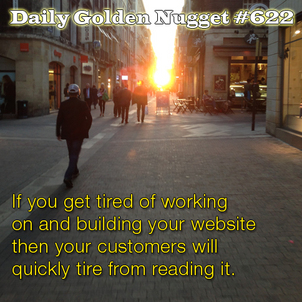 Your website is never complete. The sooner you realize that the sooner you will stop worrying about getting your website perfect, and that means less stress for you.
Your website is never complete. The sooner you realize that the sooner you will stop worrying about getting your website perfect, and that means less stress for you. As a small retail jewelry business owner you need to start your website small and then continually add to it through blog posts, educational articles, monthly newsletters, and slowly adding new products.
Having a blog area on your site allows you to randomly post your thought de jour or other random happening from your store, such as customer related love stories. This is one of the easiest ways to grow your website.
I'm a big believer of having a product catalog on your website, but it has to be a true product catalog of the items you have in your brick and mortar store. Some vendor may give you JavaScript, IFrames, Divs, or some other fancy programming code to add to your website to make their product catalog magically appear. These magic product catalogs are called micro-sites. The vendor will even entice you with ideas that it's a time savings for you, and they manage it. Forget that! I haven't found any proof yet that these micro-sites bring you money.
The only online product catalog that matters is the one that shows a true representation of inventory you have in your store, or inventory you can drop-ship or get within 24 hours if you are an e-tailer.
Managing an online product catalog is a daunting task. Assuming you have more than 1000 items in your retail store, it will take several months to manually enter them into the product database on your website, unless you can upload them from your in-store inventory management software.
Bulk inventory uploading does save a lot of time, and therefore it lowers the cost of labor to manage your website. All your inventory can be uploaded and appear in a unified online catalog. On the other hand the manual product entry does have its advantages because you can spend time specifically customizing the presentation for every product subset of your catalog.
Customizing sections of your catalog could include unique photos or long descriptions. For example, the engagement ring sub-section could have photos of brides scattered throughout the pages, while the specific Elma Gil bridal collection could have a more details description of their high standards of gem grading and metalsmithing.
The typical website structure I see has a lot of written information on the first few pages of the site, but less and less written information with each step deeper into the site. You can say your website gets "thinner" as you go deeper into the site. The exception to this is your blog, which should contain a never ending stream of information regardless what page you are on.
Thinning website content is not good for you. As people move deeper through your website they are more likely to get board and leave. Creating pages of detailed information throughout the inner pages of your site will keep people interested. As someone browses your generic engagement ring catalog they might get board, but then they found that detailed page describing the Elma Gil designer and suddenly they are interested again.
Growing your website over time doesn't have to be a purely systematic endeavor. Instead, you should allow yourself to be creative within the boundaries of your website design for every sub-section.
Never stop growing your site, and keep it interesting for your customers. If you get tired of working on your site then your customers will quickly tire from reading it.








